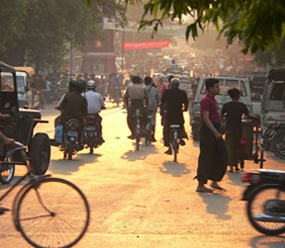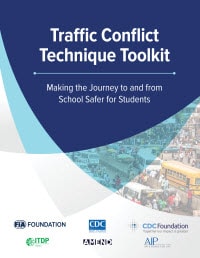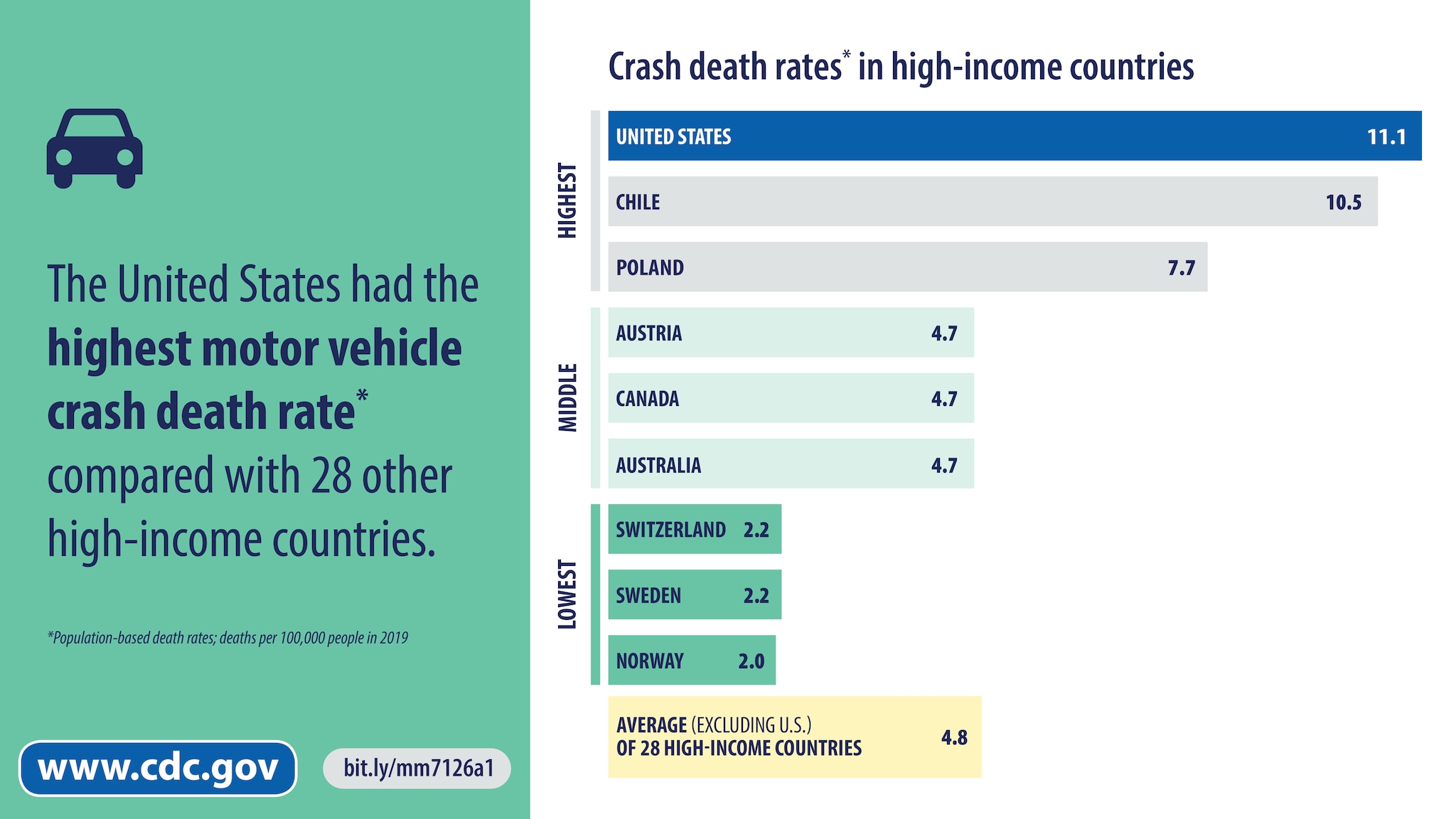Road Traffic Injuries and Deaths—A Global Problem

Road traffic crashes are a leading cause of death in the United States for people ages 1–54,1 and they are the leading cause of nonnatural death for U.S. citizens residing or traveling abroad.2–3
Throughout the world, roads are shared by cars, buses, trucks, motorcycles, mopeds, pedestrians, animals, taxis, and other travelers. Travel made possible by motor vehicles supports economic and social development in many countries. Yet each year, vehicles are involved in crashes that are responsible for millions of deaths and injuries.
Whether you’re on the road at home or abroad, know the risks and take steps to protect your health and safety.
- Each year, 1.35 million people are killed on roadways around the world.4
- Every day, almost 3,700 people are killed globally in crashes involving cars, buses, motorcycles, bicycles, trucks, or pedestrians. More than half of those killed are pedestrians, motorcyclists, or cyclists.4
- Crash injuries are estimated to be the eighth leading cause of death globally for all age groups and the leading cause of death for children and young people 5–29 years of age. More people now die in crashes than from HIV/AIDS.4
- It is estimated that fatal and nonfatal crash injuries will cost the world economy approximately $1.8 trillion dollars (in 2010 USD) from 2015–2030.5 That’s equivalent to a yearly tax of 0.12% on global GDP (gross domestic product).5
- The crash death rate is over three times higher in low-income countries than in high-income countries.4
- There were no reductions in the number of crash deaths in any low-income country from 2013 to 2016.4
- LMICs only account for 60 percent of the world’s registered vehicles but more than 90 percent of the world’s crash deaths.4
- Crash injuries place a major economic burden on LMICs.6 It is estimated that LMICs will experience approximately $834 billion dollars (in 2010 USD) in economic losses from 2015–2030 due to fatal and nonfatal crash injuries.5

Save LIVES is a technical package that includes 6 effective strategies and 22 interventions for reducing the impact of road traffic crashes.

World Day of Remembrance for Road Traffic Victims is held annually on the third Sunday in November to honor and remember the millions of people killed and injured in road crashes every year.
The Traffic Conflict Technique (TCT) Toolkit is a comprehensive guide that describes five methods that can be used to evaluate the impact of road safety interventions by collecting and analyzing traffic conflict data. It focuses on protecting pedestrians in school zones in low- and middle-income countries, but it can be used in many settings.
The toolkit was piloted in three school zones in low- and middle-income countries (Ghana, Vietnam, and Mexico) to collect data and analyze pedestrian-vehicle traffic conflicts. Results showed there was a decrease in road traffic conflicts from before implementation to after implementation in each of the three countries, providing evidence that the road safety interventions were effective. TCTs are relatively low cost, simple, and can help decisionmakers evaluate and prioritize strategies for improving road safety with real-world data. Access the TCT Toolkit and the evaluation.
New CDC research finds that the United States (U.S.) had higher rates of motor vehicle crash deaths than most other high-income countries in 2019 and lagged behind these other countries in saving lives on the road. For example, the U.S. had the highest population-based death rate (11.1 per 100,000 population). The U.S. rate was 2.3 times higher than the average rate for 28 other high-income countries (4.8 per 100,000 population). In addition, the number of crash deaths in the U.S. further increased in 2020 and 2021.
The U.S. could save more than 20,500 lives and about $280.5 million in annual medical costs (in 2019 USD) if we could reduce the population-based crash death rate to match the average rate of 28 other high-income countries in 2019. The U.S. can re-double efforts to implement proven strategies to save lives on the road and can broadly implement the Safe System approach to reduce motor vehicle crash deaths and injuries in our nation.
You can also check out this interactive data visualization chart created by the National Safety Council which displays data from the CDC Feature Publication.
Motor vehicle crashes are a public health concern both in the United States and abroad. These injuries and deaths are preventable. Whether you are a driver, passenger, cyclist, or pedestrian, take the following steps to stay safe on the road2:
- Always use a seat belt on every trip, no matter how short. Be sure to buckle up whether you are in the front seat or the back seat of the vehicle.
- Make sure children are always properly buckled in a car seat, booster seat, or seat belt that is appropriate for their age, height, and weight, and ensure they are buckled in the back seat of the vehicle.
- Always wear a helmet when driving or riding on motorcycles, motorbikes, or bicycles.
- Do not drive while impaired by alcohol or drugs, and avoid riding with a driver who is impaired.
- Obey speed limits.
- Drive without distractions. For example, don’t use a phone to text, email, or access social media while driving.
- Be alert when crossing streets, especially in countries where motorists drive on the left side of the road.
- Ride only in marked taxis, and try to ride in taxis that have seat belts.
- Avoid riding in overcrowded, overweight, or top-heavy buses or minivans.
- Access more information about road safety, overall safety, and security in every country of the world by visiting the country information page on the U.S. Department of State website. Also, review the CDC Yellow Book: Health Information for International Travelers chapters about Injury & Trauma and Road & Traffic Safety when traveling abroad.
- Review in-depth profiles about road traffic safety by country in the World Health Organization’s Global Status Reports on Road Safety.
CDC Resources
- CDC’s Global Road Safety Website
- Motor Vehicle Crash Deaths — United States and 28 Other High-Income Countries, 2015 and 2019
- Traffic Conflict Technique Toolkit: Making the Journey to and from School Safer for Students
- Observing Pedestrian-Vehicle Traffic Conflicts in School Zones to Evaluate the Effectiveness of Road Safety Interventions and Reduce Injuries in Ghana, Vietnam, and Mexico, 2019-2021
- CDC Yellow Book; Chapter 8 – Travel by Air, Land & Sea – Road & Traffic Safety
- CDC Yellow Book; Chapter 11 – Environmental Hazards & Other Noninfectious Health Risks – Injury & Trauma
External Resources
- World Day of Remembrance for Road Traffic Victims
- United Nations Global Road Safety Week
- World Health Organization (WHO): Global Status Report on Road Safety (2018)
- World Health Organization (WHO): Save LIVES: A Road Safety Technical Package
- National Safety Council – Motor-Vehicle Deaths in the U.S. Compared to the World – Injury Facts
- Centers for Disease Control and Prevention (CDC). WISQARS — Web-based Injury Statistics Query and Reporting System. Atlanta, GA: U.S. Department of Health and Human Services, Centers for Disease Control and Prevention, National Center for Injury Prevention and Control; 2022.
- Sauber-Schatz EK, Parker EM, Sleet DA, Ballesteros MF. CDC Health Information for International Travel (Yellow Book 2020 Edition). Chapter 8 – Travel by Air, Land & Sea – Road & Traffic Safety. Atlanta, GA: Centers for Disease Control and Prevention (CDC); 2020.
- S. Department of State — Bureau of Consular Affairs. U.S. Citizen Deaths Overseas. Washington, DC: U.S. Department of State, Bureau of Consular Affairs; 2020.
- World Health Organization (WHO). Global Status Report on Road Safety 2018. Geneva, Switzerland: The World Health Organization (WHO); December 2018.
- Chen S, Kuhn M, Prettner K, Bloom DE. The global macroeconomic burden of road injuries: estimates and projections for 166 countries. Lancet Planet Health. 2019;3(9):e390–398.
- World Health Organization (WHO). World Report on Road Traffic Injury Prevention. Geneva, Switzerland: The World Health Organization (WHO). Peden M, Scurfield R, Sleet D, Mohan D, Hyder AA, Jarawan E, Mathers C, eds; 2004.

